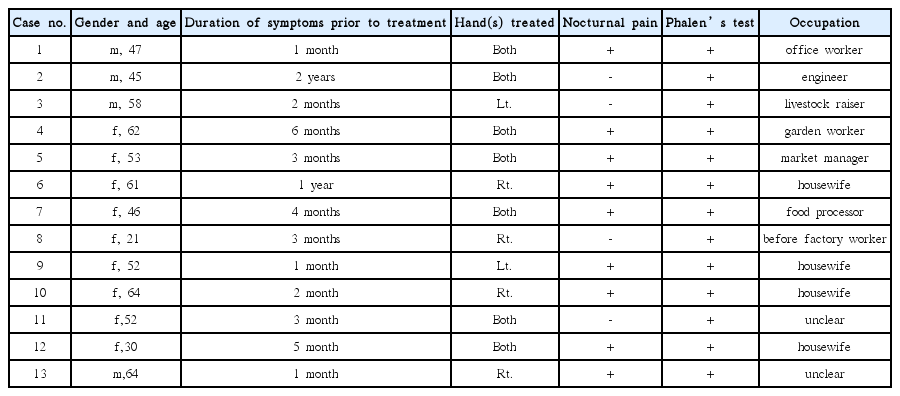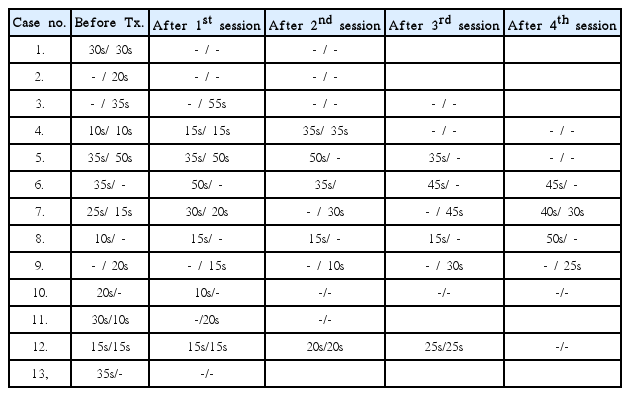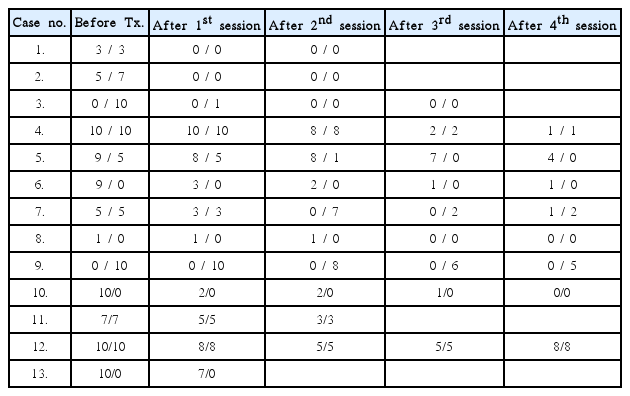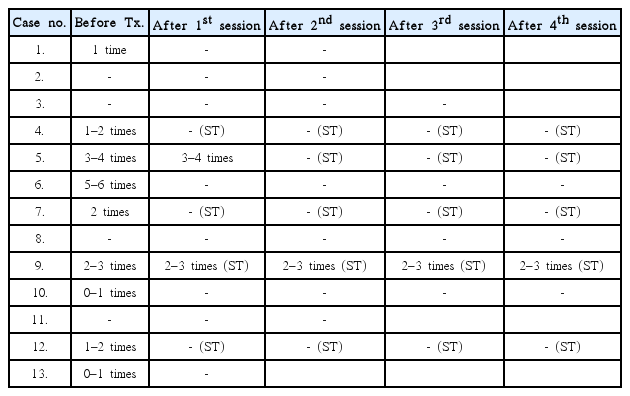Effects of Catgut -Embedding Therapy in Patients with Carpal Tunnel Syndrome: a Retrospective Pilot Study
Article information
Abstract
Objectives:
We evaluated the effect of the traditional Korean medical therapy of catgut-embedding therapy in patients with carpal tunnel syndrome (CTS).
Methods:
Thirteen patients(20 hands) with CTS underwent catgut-embedding therapy once per week for a total of 1–4 sessions. We measured the time to tingling in the fingers on performing Phalen’s test. We also had patients use a visual analog scale (VAS) to indicate the severity of tingling. We also asked about the awakening time at night due to pain and tingling. We controlled the treatment as being limited to four sessions. Even if a patient had not been treated for four sessions, we ended the patient’s treatment if symptoms resolved.
Results:
Patients who received catgut-embedding therapy showed significant improvements in the clinical symptoms of CTS. After treatment, in a total of 19 hands, the status of fourteen was changed from positive to negative in Phalen’s test and the average of tingling occurrence time in that test was delayed. Among the 20 hands, the VAS in eight hands changed to zero and the average of VAS score decreased. Furthermore, in nine patients, four could sleep well without the use of a splint.
Conclusions:
Patients undergoing this traditional Korean medical therapy showed alleviation of finger tingling after even a single treatment. We thus concluded that this traditional Korean catgut-embedding therapy, may be effective for treating CTS. However, to confirm the effects of catgut-embedding therapy on CTS, further tests are required, including under the defined, strict conditions of a randomized controlled trial.
Introduction
Carpal tunnel syndrome (CTS) is a disabling neuropathy that affects the median nerve and impairs wrist and hand function.1,2 CTS is the most prevalent form of peripheral entrapment syndrome, characterized by numbness, tingling, hand pain, and muscular dysfunction.3 The classic symptoms of CTS include pain and paresthesia along the radial side of the hand and palm,2 directly corresponding to the median nerve’s location.4–6 Nocturnal pain, which interrupts the sleep cycle, is often a result of an increase in intracarpal pressure due to flexion or extension positioning during sleep.7 The two provocative tests most commonly used in the clinical setting are Phalen’s and Tinel’s tests.8
Typically, conservative care is recommended prior to any surgical intervention for CTS.9 Conservative treatment includes splinting, local steroid injection, ultrasound, and oral steroids, which are all effective in patients with mild-to-moderate symptoms.10 The efficacy of acupuncture in the management of mild-to-moderate CTS has been investigated in some studies.11–13 Yang et al.14 showed that short-term acupuncture treatment was as effective as oral prednisolone in mild-to-moderate CTS. However, there are no case reports or studies on catgut-embedding therapy for CTS. Thus, we examined thirteen patients with carpal tunnel syndrome who were treated with catgut-embedding therapy in a retrospective study.
Methods and Materials
We treated 13 patients who were diagnosed to have carpal tunnel syndrome from March 2, 2013, to October 31, 2014. We were permitted to use their personal data after obtaining their signed consent. Furthermore, the Institutional Review Board of Wonkwang medical center in Gwangju approved this study (WK IRB 13–18). The thirteen patients(20 hands) finished treatment in four sessions and the data on these patients were analyzed.
The patients received catgut-embedding therapy once per week for a total of 1–4 sessions. They were aged between 21 and 64 years. The duration of the symptoms prior to treatment was between 1 month and 2 years. Among the thirteen patients, nine were females. The region of carpal tunnel syndrome were both hands (n = 7), the right hand (n = 4), and the left hand (n = 2). Of the thirteen patients, nine had nocturnal pain. They all had positive results on Phalen’s test (Table 1).
The treatment needle was a 4-cm, 29-G syringe (21 Century Medical Co., Ltd., Gwangju, Korea) which was used in the following way. Before embedding the needle, the treatment sites were sterilized with povidone iodide. The 4-cm, 29-G needles were subsequently embedded along the ulnar side from HT7 (Sinmun) to the 5th metacarpal bone and the radial side from LU9(Taeyeon) to the 2nd metacarpal bone. Finally, to prevent the thread being displaced from the site, the needle was taken out by rotating it in a 90° arc.
Before the treatment, the patients were asked the following questions.
When did you feel the tingling sensation when you performed the Phalen’s test?
How many times do you wake up with a tingling sensation at night?
Describe your tingling sensation on a scale of 0 (no pain) to 10 (most severe)
After treatment, we explained to the patients that they had to be careful about infection, from water, for 1 day and requested that they receive further treatment, 1 week later. Before each treatment, the patients were asked to answer the three questions. Additionally, for some patients who could not sleep well with severe nocturnal tingling, we prescribed splints.
Results
Before treatment, the patients all had a positive result on Phalen’s test. However, after the first session, the results of three patients (case 1, 2, 13) changed to negative on Phalen’s test as did one hand of one patient (case 11). After the second session, two patient’s (case 3, 10) result changed to negative as did one hand of two patient (case 5, 11). Furthermore, after the third session, another patient’s (case 4) result changed to negative. Finally, after the last session, two more patient’s (case 5, 12) result changed to negative, and four patients (case 6, 7, 8, 9) were still positive. However, the tingling sensation in Phalen’s test occurred at a later time than their earlier results. Although one patient (case 9) was treated for four sessions, the tingling sensation in this patient still occurred at the similar time (Table 2).
The extent of the tingling sensation disappeared or decreased. After the first session, the VAS of two patients (case 1, 2) changed to zero. After the second session, the VAS of one patient (case 3) changed to zero as did one hand of one patient (case 7). Furthermore, after the third session, the VAS of one patient (case 8) changed to zero as did one hand of one patient (case 5). After the last session, the VAS of one patients (case 10) changed to zero. The tingling sensation in the other hands remained but their VAS scores all decreased (Table 3).
Before treatment, nine patients experienced nocturnal tingling. After the first session, the nocturnal tingling in four patients (case 1, 6, 10, 13) resolved without the use of splints and the nocturnal tingling in three patients (case 4, 7, 12) resolved with the use of splints. After the second session, one more patient’s (case 5) nocturnal tingling disappeared with the use of a splint. However, one patient’s (case 9) nocturnal tingling was the same even with the use of a splint, and despite four treatments (Table 4).
Before treatment, the average of tingling occurrence time in Phalen’s test among 19 hands was 23.68 ± 11.407 and the average of VAS score among 20 hands was 7.30 ± 2.922. But after treatment, the average of tingling occurrence time in Phalen’s test among 19 hands was 54.21 ± 11.088 and the average of VAS score among 20 hands was 2.20 ± 2.783 (Table 5). After treatment, among nine patients, four could sleep well without the use of a splint.
Discussion
The aim of this study was to assess catgut-embedding therapy in the treatment of carpal tunnel syndrome. Our results showed that patients who received catgut-embedding therapy had significantly better improvement in the clinical symptoms of CTS. After treatment with a range from one to four sessions, the subjective symptoms showed improvement.
The carpal tunnel is composed of a bony canal, consisting of carpal bones, the roof of which is the fibrous but rigid transverse carpal ligament. The carpal tunnel contains nine flexor tendons and the median,15 which enters the tunnel in the midline slightly radial to it.16 Sensory branches from the median nerve supply the three radial digits and the radial half of the fourth digit. The palmar sensory cutaneous branch of the median nerve supplies the cutaneous skin of the palm, and arises, on average, 6 cm proximal to the transverse carpal ligament (TLC).15
The pathophysiology of CTS involves a combination of mechanical trauma, increased pressure and ischemic injury to the median nerve within the carpal tunnel.17 There are dramatic changes in fluid pressure in the carpal tunnel with wrist position; extension increases the pressure 10-fold and wrist flexion increases it 8-fold.17 Thus, repetitive hand movements have been implicated as one of many risk factors for CTS. Surgical treatment for CTS is usually in the form of a carpal tunnel release (CTR); a procedure in which the transverse carpal ligament (TCL) is cut to increase the space in the carpal tunnel and thus reduce the interstitial pressure. Approximately 70–90% of patients have good-to-excellent long-term outcomes following CTR.18 We thought that catgut-embedding therapy could reduce the pressure in the carpal tunnel in the same way as CTR.
Phalen’s and Tinel’s tests are provocative tests that are commonly used in the clinical setting. In Phalen’s test, the patient is asked to bend the wrist and keep it in that position for 60 s. The results is deemed a ‘positive’ response if this leads to pain or paresthesia in the distribution of the median nerve.19 The sensitivity of Phalen’s test is in the range of 67–83%, while the specificity ranges between 40% and 98%.20–22 Tinel’s test is performed by tapping over the volar surface of the wrist. A positive response results if this causes paresthesia in the fingers innervated by the median nerve: the thumb, index, middle finger and the radial side of the ring finger.23 Tinel’s test has a sensitivity in the range of 48–73%, while the specificity is 30–94%.20–22 Thus, in our study, we used Phalen’s test as a tool for diagnosis.
Double crush syndrome was first described by Upton and McComas,24 and it refers to the concept that impingement of the spinal nerves and peripheral nerves of the arm may result in a more complex clinical presentation. We thus thought that this may have been the cause of the lack of improvement in one patient (case 9) while undergoing this treatment.
Catgut-embedding therapy, also called “acupoint embedding therapy,” is a recently developed therapy that uses specialized tools.25 Embedded alien substances stimulate acupoints and help maintain stimulation. In catgut-embedding therapy, metal tools are applied at acupoints, and alien substances are embedded to stimulate the acupoints.26 It is used for both chronic and acute diseases, and it is applicable to 200 kinds of diseases in medical specialties from internal medicine to pediatrics to dermatology.27 Based on meridian theory, recent studies have focused on the fields of plastic surgery, cosmetics, and hair loss.28
Conclusions
We studied thirteen patients with carpal tunnel syndrome who were treated with catgut-embedding therapy and concluded that catgut-embedding therapy may have an effect on carpal tunnel syndrome. Even a single session of treatment improved the symptoms of CTS. We expect this study will help conservative treatment and management of carpal tunnel syndrome in clinics. However, we could not exclude some factors, such as the effect of splints and the duration of symptoms prior to treatment. Thus, there is a need to confirm the effects of catgut-embedding therapy on carpal tunnel syndrome under the defined and strict conditions of a randomized controlled trial.
Acknowledgements
This paper was supported by Wonkwang University in 2014.
Notes
Conflict of interest statement
The authors do not have any conflicts concerning this paper.




